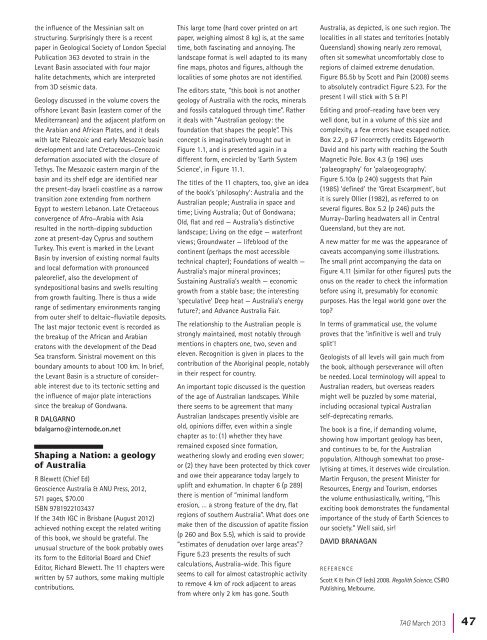TAG 166 - Geological Society of Australia
TAG 166 - Geological Society of Australia
TAG 166 - Geological Society of Australia
You also want an ePaper? Increase the reach of your titles
YUMPU automatically turns print PDFs into web optimized ePapers that Google loves.
the influence <strong>of</strong> the Messinian salt onstructuring. Surprisingly there is a recentpaper in <strong>Geological</strong> <strong>Society</strong> <strong>of</strong> London SpecialPublication 363 devoted to strain in theLevant Basin associated with four majorhalite detachments, which are interpretedfrom 3D seismic data.Geology discussed in the volume covers the<strong>of</strong>fshore Levant Basin (eastern corner <strong>of</strong> theMediterranean) and the adjacent platform onthe Arabian and African Plates, and it dealswith late Paleozoic and early Mesozoic basindevelopment and late Cretaceous–Cenozoicdeformation associated with the closure <strong>of</strong>Tethys. The Mesozoic eastern margin <strong>of</strong> thebasin and its shelf edge are identified nearthe present-day Israeli coastline as a narrowtransition zone extending from northernEgypt to western Lebanon. Late Cretaceousconvergence <strong>of</strong> Afro–Arabia with Asiaresulted in the north-dipping subductionzone at present-day Cyprus and southernTurkey. This event is marked in the LevantBasin by inversion <strong>of</strong> existing normal faultsand local deformation with pronouncedpaleorelief, also the development <strong>of</strong>syndepositional basins and swells resultingfrom growth faulting. There is thus a widerange <strong>of</strong> sedimentary environments rangingfrom outer shelf to deltaic–fluviatile deposits.The last major tectonic event is recorded asthe breakup <strong>of</strong> the African and Arabiancratons with the development <strong>of</strong> the DeadSea transform. Sinistral movement on thisboundary amounts to about 100 km. In brief,the Levant Basin is a structure <strong>of</strong> considerableinterest due to its tectonic setting andthe influence <strong>of</strong> major plate interactionssince the breakup <strong>of</strong> Gondwana.R DALGARNObdalgarno@internode.on.netShaping a Nation: a geology<strong>of</strong> <strong>Australia</strong>R Blewett (Chief Ed)Geoscience <strong>Australia</strong> & ANU Press, 2012,571 pages, $70.00ISBN 9781922103437If the 34th IGC in Brisbane (August 2012)achieved nothing except the related writing<strong>of</strong> this book, we should be grateful. Theunusual structure <strong>of</strong> the book probably owesits form to the Editorial Board and ChiefEditor, Richard Blewett. The 11 chapters werewritten by 57 authors, some making multiplecontributions.This large tome (hard cover printed on artpaper, weighing almost 8 kg) is, at the sametime, both fascinating and annoying. Thelandscape format is well adapted to its manyfine maps, photos and figures, although thelocalities <strong>of</strong> some photos are not identified.The editors state, “this book is not anothergeology <strong>of</strong> <strong>Australia</strong> with the rocks, mineralsand fossils catalogued through time”. Ratherit deals with “<strong>Australia</strong>n geology: thefoundation that shapes the people”. Thisconcept is imaginatively brought out inFigure 1.1, and is presented again in adifferent form, encircled by ‘Earth SystemScience’, in Figure 11.1.The titles <strong>of</strong> the 11 chapters, too, give an idea<strong>of</strong> the book’s ‘philosophy’: <strong>Australia</strong> and the<strong>Australia</strong>n people; <strong>Australia</strong> in space andtime; Living <strong>Australia</strong>; Out <strong>of</strong> Gondwana;Old, flat and red — <strong>Australia</strong>’s distinctivelandscape; Living on the edge — waterfrontviews; Groundwater — lifeblood <strong>of</strong> thecontinent (perhaps the most accessibletechnical chapter); Foundations <strong>of</strong> wealth —<strong>Australia</strong>’s major mineral provinces;Sustaining <strong>Australia</strong>’s wealth — economicgrowth from a stable base; the interesting‘speculative’ Deep heat — <strong>Australia</strong>’s energyfuture?; and Advance <strong>Australia</strong> Fair.The relationship to the <strong>Australia</strong>n people isstrongly maintained, most notably throughmentions in chapters one, two, seven andeleven. Recognition is given in places to thecontribution <strong>of</strong> the Aboriginal people, notablyin their respect for country.An important topic discussed is the question<strong>of</strong> the age <strong>of</strong> <strong>Australia</strong>n landscapes. Whilethere seems to be agreement that many<strong>Australia</strong>n landscapes presently visible areold, opinions differ, even within a singlechapter as to: (1) whether they haveremained exposed since formation,weathering slowly and eroding even slower;or (2) they have been protected by thick coverand owe their appearance today largely touplift and exhumation. In chapter 6 (p 289)there is mention <strong>of</strong> “minimal landformerosion, … a strong feature <strong>of</strong> the dry, flatregions <strong>of</strong> southern <strong>Australia</strong>”. What does onemake then <strong>of</strong> the discussion <strong>of</strong> apatite fission(p 260 and Box 5.5), which is said to provide“estimates <strong>of</strong> denudation over large areas”?Figure 5.23 presents the results <strong>of</strong> suchcalculations, <strong>Australia</strong>-wide. This figureseems to call for almost catastrophic activityto remove 4 km <strong>of</strong> rock adjacent to areasfrom where only 2 km has gone. South<strong>Australia</strong>, as depicted, is one such region. Thelocalities in all states and territories (notablyQueensland) showing nearly zero removal,<strong>of</strong>ten sit somewhat uncomfortably close toregions <strong>of</strong> claimed extreme denudation.Figure B5.5b by Scott and Pain (2008) seemsto absolutely contradict Figure 5.23. For thepresent I will stick with S & P!Editing and pro<strong>of</strong>-reading have been verywell done, but in a volume <strong>of</strong> this size andcomplexity, a few errors have escaped notice.Box 2.2, p 67 incorrectly credits EdgeworthDavid and his party with reaching the SouthMagnetic Pole. Box 4.3 (p 196) uses‘palaeography’ for ‘palaeogeography’.Figure 5.10a (p 240) suggests that Pain(1985) ‘defined’ the ‘Great Escarpment’, butit is surely Ollier (1982), as referred to onseveral figures. Box 5.2 (p 246) puts theMurray–Darling headwaters all in CentralQueensland, but they are not.A new matter for me was the appearance <strong>of</strong>caveats accompanying some illustrations.The small print accompanying the data onFigure 4.11 (similar for other figures) puts theonus on the reader to check the informationbefore using it, presumably for economicpurposes. Has the legal world gone over thetop?In terms <strong>of</strong> grammatical use, the volumeproves that the ‘infinitive is well and trulysplit’!Geologists <strong>of</strong> all levels will gain much fromthe book, although perseverance will <strong>of</strong>tenbe needed. Local terminology will appeal to<strong>Australia</strong>n readers, but overseas readersmight well be puzzled by some material,including occasional typical <strong>Australia</strong>nself-deprecating remarks.The book is a fine, if demanding volume,showing how important geology has been,and continues to be, for the <strong>Australia</strong>npopulation. Although somewhat too proselytisingat times, it deserves wide circulation.Martin Ferguson, the present Minister forResources, Energy and Tourism, endorsesthe volume enthusiastically, writing, “Thisexciting book demonstrates the fundamentalimportance <strong>of</strong> the study <strong>of</strong> Earth Sciences toour society.” Well said, sir!DAVID BRANAGANR E F E R E N C EScott K & Pain CF (eds) 2008. Regolith Science, CSIROPublishing, Melbourne.<strong>TAG</strong> March 2013| 47
















